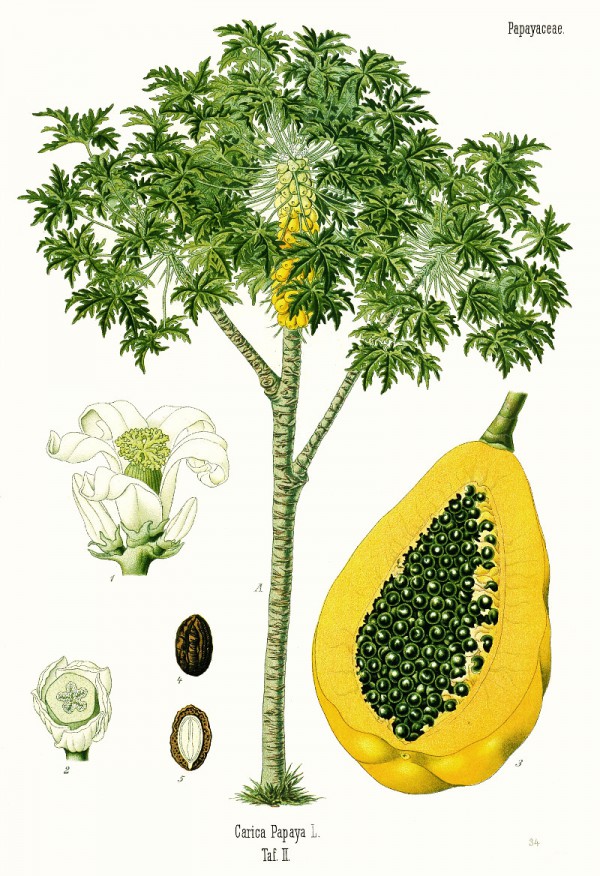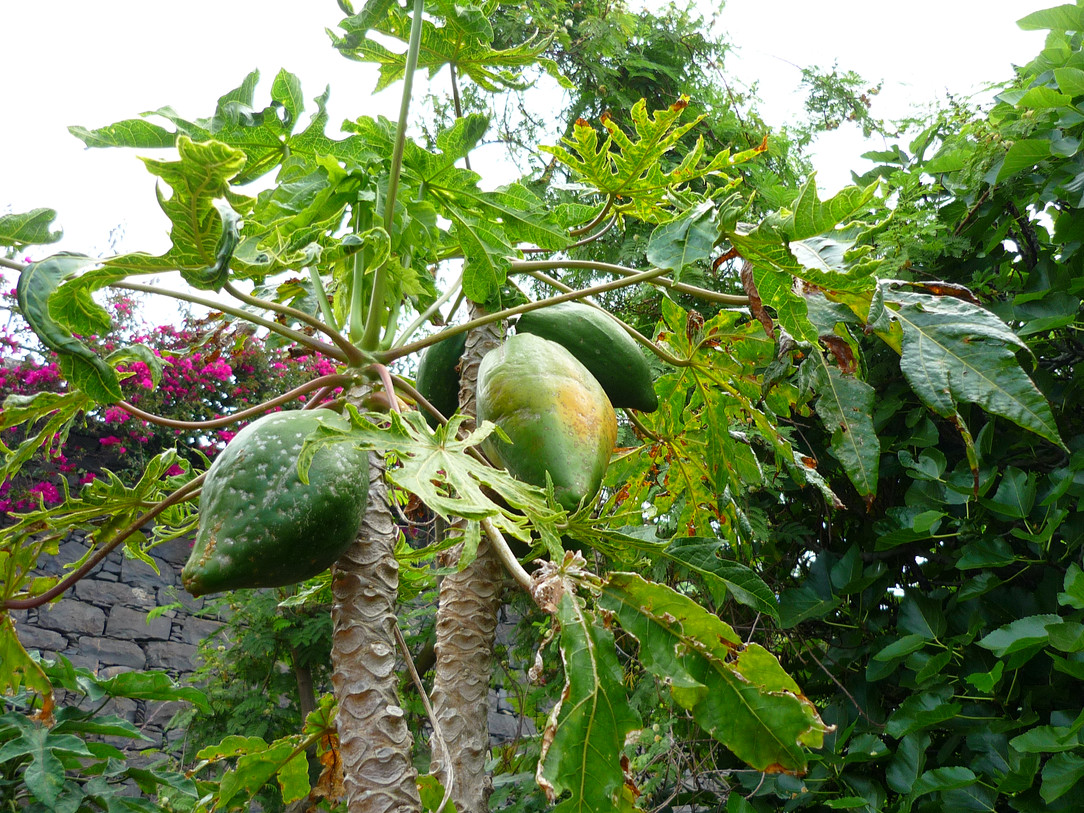Carica papaya L. - Caricaceae - papaya, melon tree, Papaya
Evergreen tree-like plant, up to 6m tall, native to tropical South America, cultivated elsewhere; leaves arranged like a tuft at the top of the stem, large, long-petioled, palmately lobed; inflorescences axillary; flowers - the male ones hanging in pendulous panicles, the yellowish-white female in shortly branched clusters; ovary with 3-5 united carpels, 5 stigmas; fruits large, obovate to pear-shaped; pulp yellow to orange-red, central cavity with many dark grey seeds. The ripe fruit flesh of the papaya is usually eaten raw.
There are male, female, and hermaphrodite papaya plants. These forms are expressed in the plant’s flower.
http://www.ctahr.hawaii.edu/oc/freepubs/pdf/F_N-5.pdf
Linalool was found in all headspace samples of C.papaya fruits, but showed a pronounced increase in the transition from one-fourth ripe to fully ripe fruit. The trapped samples also contained aldehydes like hexanal, octanal, nonanal, decanal, and benzaldehyde; esters like ethyl acetate and methyl salicylate; and Nitrogen compounds like methyl thiocyanate, phenylacetonitrile and benzyl isothiocyanate.
[Flath, Robert A., et al. „Headspace examination of volatile emissions from ripening papaya (Carica papaya L., Solo variety).“ Journal of Agricultural and Food Chemistry 38.4 (1990): 1060-1063]
Esters were the most abundant compounds of the aroma volatiles from fresh papaya fruit, with methyl butanoate (48%) as major constituent. Products of benzyl glucosinolate degradation were identified, but no benzyl isothiocyanate was found.
[Volatile components of papaya (Carica papaya L.) with particular reference to glucosinolate products., MacLeod, A.J., Pieris, N.M., Journal of Agricultural and Food Chemistry, Vol.31(5), 1983, 1005-1008]
Methyl butanoate, ethyl butanoate, 3-methyl-1-butanol and 1-butanol were found to be the major volatile components of fresh papaya fruit. The esters of lower fatty acids were considered to contribute much to the typical papaya flavour.
[Volatile components of papaya (Carica papaya L., Maradol variety) fruit. Pino, J. A., Almora, K., Marbot, R., Flavour and fragrance journal, Vol.18(6), 2003, 492-496]
The volatiles of different cultivars of Carica papaya fruits were extracted using liquid-liquid-extraction and stirbar-sorptive extraction (SBSE). Character impact compounds which contribute to the aroma impression were characterized by GC-O, identification and semi-quantification were accomplished with GC-MS. The aroma patterns differ significantly between the genotypes resulting in very different sensory qualities. Especially the existence and content of terpenes show a high variability. A huge number of compounds
contributed to papaya fruit aroma, but hexanal, (Z)-2-pentenol, nonanal, (Z)-linalool oxide, linalool, DMSO, butanoic acid, verbenone, benzyl butanoate, delta-octalactone and benzyl isothiocyanate were named as character impact odorants.
[Ulrich, Detlef, and C. H. Wijaya. „Volatile patterns of different papaya (Carica papaya L.) varieties.“ Journal of Applied Botany and Food Quality 83.2 (2010): 128-132]
Aroma extract dilution analysis (AEDA) and odour activity value (OAV) determination were applied to estimate the most odour-active volatile compounds from papaya fruit cv. Red Maradol. Overall, esters were the dominant class of constituents. 3-Methylbutanal (0.4mg/kg), methyl butanoate (2.3mg/kg), 3-methylbutan-1-ol (0.8mg/kg), ethyl butanoate (0.8mg/kg), methyl hexanoate (0.3mg/kg), limonene (0.3mg/kg), benzyl isothiocyanate (0.2mg/kg) and some fatty acids and their correspondend esters like dodecanoic acid, tetradecanoic acid, ethyl tetradecanoate, pentadecanoic acid, and hexadecanoic acid were the most abundant volatiles present. Of the 26 compounds with FD >=32, the highest FD (512 and 1024) showed 1-hexen-3-one, ethyl butanoate, methyl benzoate, benzyl isothiocyanate, and (E)-β-ionone. These compounds had also the highest OAV (>100). Components with FD=256 were methyl butanoate (OAV 44), hexanal (OAV 4), (E)-hex-3-en-1-ol (OAV 11), linalool (OAV 13). Components with FD=64 were 1-penten-3-one (OAV 10), methyl hexanoate (OAV 9), ethyl hexanoate (OAV 10), limonene (OAV 37), and ethyl benzoate (OAV 4).
[Odour-active compounds in papaya fruit cv. Red Maradol., Pino, J.A., Food chemistry, Vol.146, 2014, 120-126]
Raw papain (Papainum crudum) is the dried and cleansed latex of C.papaya. The enzyme mixture produced from raw papain is also called papain and contains papaya proteinase I (papain), chymopapain (A,B), and papaya peptidase A (caricain).
„Benzyl isothiocyanate is the major if not sole bioactive principle in papaya seeds that is effective against nematodes. Benzyl thiocyanate, benzyl cyanide, and benzonitrile were not detected in papaya seed preparations and glucogenic cyanides did not account for the anthelmintic activity detected.“
[Benzyl isothiocyanate is the chief or sole anthelmintic in papaya seed extracts., Kermanshai, R., McCarry, B.E., Rosenfeld, J., Summers, P.S., Weretilnyk, E.A., Sorger, G.J., Phytochemistry, 57(3), 2001, 427-435]
The mustard oil liberated enzymatically on maceration of the fruit seeds in water or an organic solvent, is benzyl isothiocyanate (0.2-0.5%). Benzyl thiourea was found only in traces (0.03%) or is formed from benzyl isothiocyanate when ammonia is present during extraction.
[The mustard oil of papaya seed., Ettlinger, M.G., Hodgkins, J.E., The Journal of Organic Chemistry, 21(2), 1956, 204-205]
All the green parts (especially the leaves) and the seeds of papaya contain the (bitter) alkaloid carpaine.
[Carpaine: An alkaloid of Carica papaya-its chemistry and pharmacology., Burdick, E.M., Economic Botany, 25(4), 1971, 363-365]
„Many plants contain latex that exudes when leaves are damaged, and a number of proteins and enzymes have been found in it. The roles of those latex proteins and enzymes are as yet poorly understood. We found that papain, a cysteine protease in latex of the Papaya tree (Carica papaya, Caricaceae), is a crucial factor in the defense of the papaya tree against lepidopteran larvae such as oligophagous Samia ricini (Saturniidae) and two notorious polyphagous pests, Mamestra brassicae (Noctuidae) and Spodoptera litura (Noctuidae). Leaves of a number of laticiferous plants, including papaya and a wild fig, Ficus virgata (Moraceae), showed strong toxicity and growth inhibition against lepidopteran larvae, though no apparent toxic factors from these species have been reported. When the latex was washed off, the leaves of these lactiferous plants lost toxicity. Latexes of both papaya and the wild fig were rich in cysteine-protease activity. E-64, a cysteine protease-specific inhibitor, completely deprived the leaves of toxicity when painted on the surface of papaya and fig leaves. Cysteine proteases, such as papain, ficin, and bromelain, all showed toxicity. The results suggest that plant latex and the proteins in it, cysteine proteases in particular, provide plants with a general defense mechanism against herbivorous insects.“
[Papain protects papaya trees from herbivorous insects: role of cysteine proteases in latex. Konno, K., Hirayama, C., Nakamura, M., Tateishi, K., Tamura, Y., Hattori, M. and Kohno, K., The Plant Journal, Vol.37, 2004, 370-378]

Köhler, F.E., Medizinal Pflanzen, vol. 3: t. 34 (1890)
http://plantgenera.org/species.php?id_species=205571

Carica papaya, CC BY-SA 3.0, Author: Andreas Kraska